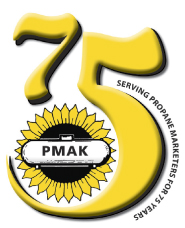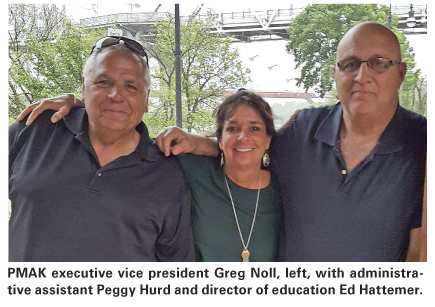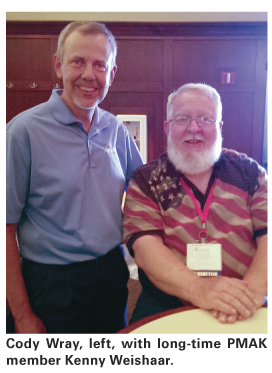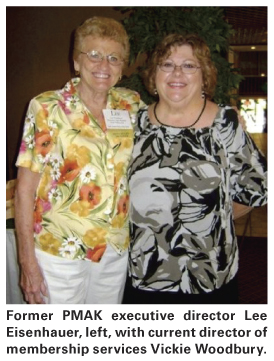Tuesday, June 13, 2017
Seventy-five years ago a group of Kansas LP-Gas dealers and associates formed an association to act as a “voice” for the industry in Kansas. It was 1942 and the LP-gas business at the time was considered depression-proof, reaching new highs in sales and opening new markets while many industries were making a slow recovery. The rapid growth caused many industry members to believe regulatory growth was needed as well. The initial association members came together because they wanted a “champion” in the writing of any regulations pertaining to their industry. 
Although growth of the association was slowed by the war years of 1942 to 1945, members would still meet on weekends at various locations, have dinner, and discuss the needs of their new industry. By 1945, the membership of the Kansas LP-Gas Association (KLPGA) totaled 40 members.
In 1946, Wichita became the official state headquarters for the Kansas LP-Gas Association. Rudolph ‘Rudy’ Mahnke was named as the first executive vice president and Elsie Martin became the first secretary. The inaugural Kansas LP-Gas Convention and Trade Show was held October 21 and 22 that year with 234 attendees and 13 booth spaces sold. The convention was touted with the statement that “long, tiresome, drawn-out speeches are prohibited on the program. This is an LP-Gas Convention — not a literary league.” That year association membership totaled 150.
Challenges for the industry in the early days of the association included a fuel shortage during the winter of 1946-47 and a fire in Russell, Kan. that resulted in a lot of negative publicity for LP-gas, although it was later determined the fire was caused by natural gas. This incident resulted in several cities in Kansas creating ordinances establishing standards for LP-gas equipment being installed within the city limits. The association office sent out a notice to the various city governing bodies about the availability of a “model city ordinance” originated by the National LP-Gas Association.
In the 1950s, the association experienced further challenges as its membership dropped to just 79. In 1954, association president Clyde Cheatum began an all-out effort to acquire new members, which resulted in a total of 101 additions to the roster. In 1955, the association held its 10th Annual Kansas LP-Gas Convention in Wichita, and that year saw the creation of a Kansas LP-Gas Association Disability Plan, with three claims that required payment for a broken leg, a case of mumps, and an accident.
The association began publication of a four-page newsletter for the people of the gas industry in Kansas in the early 1960s. A line of succession to the office of association president was put in place, following the board of directors’ goal for those becoming president to have already served in lower positions such as secretary-treasurer and vice-president and therefore be well-versed in all areas of the association. A new program called “Gold Star Awards” was formed to recognize members who excelled in the field of safety, education, and public relations.
In 1965, the 20th Annual Kansas LP-Gas Convention moved to Kansas City, Kan. to attract more participation as the membership had reached an all-time low of less than 50. But in 1967, an era of renewal and vitality began as the association positioned itself as equally representing all independent dealers and Farmland Industries Inc. dealers. It was believed that only the efforts of an unbiased association would bring about a program to ensure a profitable future in the Kansas LP-gas industry. Association services without reproach and a robust legislative program were promised to rebuild the membership. Teams were formed to visit each LP-gas company. A new executive secretary, Ken Johnson, was named to head the association.
The Johnson era, which lasted 19 years, began with a move of the association office to Topeka in recognition that it was important to monitor the legislature and to have an office in the center of all governmental activities. In another area, Johnson also recognized that the association needed social interaction as well as business discussion. As a result, a “New Fall Conference” was held at the Holiday Inn in Topeka that included a barbecue and a trip to the traditional K-State-KU football game. Insurance programs, tax programs, and business meetings on management were launched. District meetings were improved to attract those who truly wanted to gain knowledge to benefit their business. By the mid-70s, association membership reached an all-time high.
Lee Eisenhauer served as a secretary for Ken Johnson twice during his tenure prior to assuming the executive duties herself for 19 years beginning in 1986. During her tenure, Eisenhauer witnessed the association’s goal of including social interaction become highly successful. When asked about her greatest achievement in which she had the most pride, she didn’t describe a legislative victory or a specific goal reached. Surprisingly, or maybe not, Eisenhauer said, “We had so many Mom and Pop operations and for years the wives were just as involved in the association as the husbands. I just really enjoyed that our association was like a big family.” There were many accomplishments during Eisenhauer’s years of leadership, including a name change to “Propane Marketers Association of Kansas (PMAK).” In 1992, other associations were moving toward having “Propane” in the association name rather than LP-gas. Butane was no longer a commonly sold LP-gas, and many believed it was best to identify “propane” more specifically in the association name. Also, a movement was afoot toward referring to retail companies as “marketers” rather than “dealers.” The title “Propane Marketers Association of Kansas” was born in November 1992, at the close of the group’s 50th year. “As KLPGA, we were confused by some with the Kansas Ladies Pro Golf Association,” Eisenhauer said, “We definitely got enough of their mail!”
There were many accomplishments during Eisenhauer’s years of leadership, including a name change to “Propane Marketers Association of Kansas (PMAK).” In 1992, other associations were moving toward having “Propane” in the association name rather than LP-gas. Butane was no longer a commonly sold LP-gas, and many believed it was best to identify “propane” more specifically in the association name. Also, a movement was afoot toward referring to retail companies as “marketers” rather than “dealers.” The title “Propane Marketers Association of Kansas” was born in November 1992, at the close of the group’s 50th year. “As KLPGA, we were confused by some with the Kansas Ladies Pro Golf Association,” Eisenhauer said, “We definitely got enough of their mail!”
When Eisenhauer was hired to head the association, retail propane was 35 cents per gallon. “It became tougher to run a retail company during my years due to more rules and regulations. We had to work harder to help our smaller marketers keep up with all that the government required of them,” she said. “In many cases, smaller marketers sold out to larger retail propane companies.”
Greg Noll, current executive vice-president heading the association, has also observed the continued trend of larger companies acquiring smaller companies, “This will probably continue to be the trend. We will likely change as well with changing times.” He cites the passing of the bill to create the Kansas Propane Education and Research Council as well as its accomplishments so far as a big success story. Noll described the KanPERC as successful in doing exactly what it was intended do. “We set it up to provide propane safety training in the industry to retailers as well as end-users.” KanPERC is now assessing 3/10 of one cent per gallon to make CETP (Certified Employee Training Program) training available via the Fire Marshall or other qualified instructors. During Noll’s tenure as executive vice president, a building was purchased in Topeka for KanPERC to convert and use as a training facility for all training. The association offices are located in the KanPERC Training Center as well.
Don Sutton, president of the association when KanPERC was enacted, noted, “We had a lot of trips to Topeka to get that passed. A lot of people helped. We had to get it passed first through the House and then the Senate.” Sutton appreciates the friendships made in the propane industry through his many years before retiring from Tri-State Tank, which he owned 10 years ago. “I always enjoyed the family atmosphere. I met a lot of friends and enjoyed many business relationships because of PMAK!”
Kenny Weishaar is another long-time member of PMAK. “He gave a lot of time and talent to the association,” Eisenhauer said. For many years, he would travel the state both while he was a retail marketer and while he worked for Fairbank Equipment, often speaking at Kansas district dinners. “It was helpful to business at Fairbank for me to go to events and share propane knowledge and I enjoyed it,” Weishaar said. He taught about OPDs, replacing regulators, and much more about safety and compliance.
The longest serving leader of the Propane Marketers Association of Kansas is Vickie Woodbury, who began 27 years ago as an administrative assistant and is now director of membership services. In 1990, Lee Eisenhauer needed a new assistant immediately and called a few friends for help. After overhearing a phone conversation, Woodbury contacted Eisenhauer and introduced herself as “Your next assistant.” Eisenhauer remembers Woodbury had no association experience but she seemed willing and eager to learn. “She turned out to be wonderful!” Eisenhauer said.
Today, she counts Woodbury as one of her best friends. Almost every summer Eisenhauer comes out of retirement to visit Woodbury and other friends at the Mid-States Propane Expo, where even though the format, faces, and issues have changed, it still feels like a family! —Pat Thornton

Although growth of the association was slowed by the war years of 1942 to 1945, members would still meet on weekends at various locations, have dinner, and discuss the needs of their new industry. By 1945, the membership of the Kansas LP-Gas Association (KLPGA) totaled 40 members.
In 1946, Wichita became the official state headquarters for the Kansas LP-Gas Association. Rudolph ‘Rudy’ Mahnke was named as the first executive vice president and Elsie Martin became the first secretary. The inaugural Kansas LP-Gas Convention and Trade Show was held October 21 and 22 that year with 234 attendees and 13 booth spaces sold. The convention was touted with the statement that “long, tiresome, drawn-out speeches are prohibited on the program. This is an LP-Gas Convention — not a literary league.” That year association membership totaled 150.
Challenges for the industry in the early days of the association included a fuel shortage during the winter of 1946-47 and a fire in Russell, Kan. that resulted in a lot of negative publicity for LP-gas, although it was later determined the fire was caused by natural gas. This incident resulted in several cities in Kansas creating ordinances establishing standards for LP-gas equipment being installed within the city limits. The association office sent out a notice to the various city governing bodies about the availability of a “model city ordinance” originated by the National LP-Gas Association.

In the 1950s, the association experienced further challenges as its membership dropped to just 79. In 1954, association president Clyde Cheatum began an all-out effort to acquire new members, which resulted in a total of 101 additions to the roster. In 1955, the association held its 10th Annual Kansas LP-Gas Convention in Wichita, and that year saw the creation of a Kansas LP-Gas Association Disability Plan, with three claims that required payment for a broken leg, a case of mumps, and an accident.
The association began publication of a four-page newsletter for the people of the gas industry in Kansas in the early 1960s. A line of succession to the office of association president was put in place, following the board of directors’ goal for those becoming president to have already served in lower positions such as secretary-treasurer and vice-president and therefore be well-versed in all areas of the association. A new program called “Gold Star Awards” was formed to recognize members who excelled in the field of safety, education, and public relations.

In 1965, the 20th Annual Kansas LP-Gas Convention moved to Kansas City, Kan. to attract more participation as the membership had reached an all-time low of less than 50. But in 1967, an era of renewal and vitality began as the association positioned itself as equally representing all independent dealers and Farmland Industries Inc. dealers. It was believed that only the efforts of an unbiased association would bring about a program to ensure a profitable future in the Kansas LP-gas industry. Association services without reproach and a robust legislative program were promised to rebuild the membership. Teams were formed to visit each LP-gas company. A new executive secretary, Ken Johnson, was named to head the association.
The Johnson era, which lasted 19 years, began with a move of the association office to Topeka in recognition that it was important to monitor the legislature and to have an office in the center of all governmental activities. In another area, Johnson also recognized that the association needed social interaction as well as business discussion. As a result, a “New Fall Conference” was held at the Holiday Inn in Topeka that included a barbecue and a trip to the traditional K-State-KU football game. Insurance programs, tax programs, and business meetings on management were launched. District meetings were improved to attract those who truly wanted to gain knowledge to benefit their business. By the mid-70s, association membership reached an all-time high.
Lee Eisenhauer served as a secretary for Ken Johnson twice during his tenure prior to assuming the executive duties herself for 19 years beginning in 1986. During her tenure, Eisenhauer witnessed the association’s goal of including social interaction become highly successful. When asked about her greatest achievement in which she had the most pride, she didn’t describe a legislative victory or a specific goal reached. Surprisingly, or maybe not, Eisenhauer said, “We had so many Mom and Pop operations and for years the wives were just as involved in the association as the husbands. I just really enjoyed that our association was like a big family.”

When Eisenhauer was hired to head the association, retail propane was 35 cents per gallon. “It became tougher to run a retail company during my years due to more rules and regulations. We had to work harder to help our smaller marketers keep up with all that the government required of them,” she said. “In many cases, smaller marketers sold out to larger retail propane companies.”
Greg Noll, current executive vice-president heading the association, has also observed the continued trend of larger companies acquiring smaller companies, “This will probably continue to be the trend. We will likely change as well with changing times.” He cites the passing of the bill to create the Kansas Propane Education and Research Council as well as its accomplishments so far as a big success story. Noll described the KanPERC as successful in doing exactly what it was intended do. “We set it up to provide propane safety training in the industry to retailers as well as end-users.” KanPERC is now assessing 3/10 of one cent per gallon to make CETP (Certified Employee Training Program) training available via the Fire Marshall or other qualified instructors. During Noll’s tenure as executive vice president, a building was purchased in Topeka for KanPERC to convert and use as a training facility for all training. The association offices are located in the KanPERC Training Center as well.
Don Sutton, president of the association when KanPERC was enacted, noted, “We had a lot of trips to Topeka to get that passed. A lot of people helped. We had to get it passed first through the House and then the Senate.” Sutton appreciates the friendships made in the propane industry through his many years before retiring from Tri-State Tank, which he owned 10 years ago. “I always enjoyed the family atmosphere. I met a lot of friends and enjoyed many business relationships because of PMAK!”
Kenny Weishaar is another long-time member of PMAK. “He gave a lot of time and talent to the association,” Eisenhauer said. For many years, he would travel the state both while he was a retail marketer and while he worked for Fairbank Equipment, often speaking at Kansas district dinners. “It was helpful to business at Fairbank for me to go to events and share propane knowledge and I enjoyed it,” Weishaar said. He taught about OPDs, replacing regulators, and much more about safety and compliance.
The longest serving leader of the Propane Marketers Association of Kansas is Vickie Woodbury, who began 27 years ago as an administrative assistant and is now director of membership services. In 1990, Lee Eisenhauer needed a new assistant immediately and called a few friends for help. After overhearing a phone conversation, Woodbury contacted Eisenhauer and introduced herself as “Your next assistant.” Eisenhauer remembers Woodbury had no association experience but she seemed willing and eager to learn. “She turned out to be wonderful!” Eisenhauer said.
Today, she counts Woodbury as one of her best friends. Almost every summer Eisenhauer comes out of retirement to visit Woodbury and other friends at the Mid-States Propane Expo, where even though the format, faces, and issues have changed, it still feels like a family! —Pat Thornton

